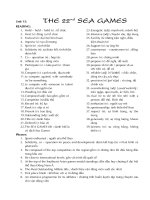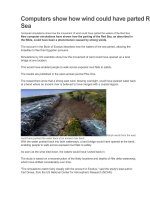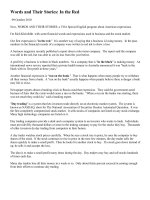Parted Red Sea
Bạn đang xem bản rút gọn của tài liệu. Xem và tải ngay bản đầy đủ của tài liệu tại đây (113.12 KB, 2 trang )
Computers show how wind could have parted Red
Sea
Computer simulations show how the movement of wind could have parted the waters of the Red Sea
New computer simulations have shown how the parting of the Red Sea, as described in
the Bible, could have been a phenomenon caused by strong winds.
The account in the Book of Exodus describes how the waters of the sea parted, allowing the
Israelites to flee their Egyptian pursuers.
Simulations by US scientists show how the movement of wind could have opened up a land
bridge at one location.
This would have enabled people to walk across exposed mud flats to safety.
The results are published in the open-access journal Plos One.
The researchers show that a strong east wind, blowing overnight, could have pushed water back
at a bend where an ancient river is believed to have merged with a coastal lagoon.
63mph winds from the east
could have pushed the water back at an ancient river bend
With the water pushed back into both waterways, a land bridge would have opened at the bend,
enabling people to walk across exposed mud flats to safety.
As soon as the wind died down, the waters would have rushed back in.
The study is based on a reconstruction of the likely locations and depths of Nile delta waterways,
which have shifted considerably over time.
"The simulations match fairly closely with the account in Exodus," said the study's lead author
Carl Drews, from the US National Center for Atmospheric Research (NCAR).
"The parting of the waters can be understood through fluid dynamics. The wind moves the water
in a way that's in accordance with physical laws, creating a safe passage with water on two
sides and then abruptly allowing the water to rush back in."
The study is part of a larger research project by Mr Drews into the impacts of winds on water
depths, including the extent to which Pacific Ocean typhoons can drive storm surges.
By pin-pointing a possible site south of the Mediterranean Sea for the crossing, the study also
could be of benefit to archaeologists seeking to research the account.
A way through
In the Book of Exodus, Moses and the fleeing Israelites became trapped between the Pharaoh's
advancing chariots and a body of water that has been variously translated as the Red Sea or the
Sea of Reeds.
The Biblical account says that, as the Pharaoh's army
followed, the waters rushed in
In a divine miracle, the account says, a mighty east wind blew all night, splitting the waters and
leaving a passage of dry land with walls of water on both sides.
The Israelites were able to flee to the other shore. But when the Egyptian Pharaoh's army
attempted to pursue them in the morning, the waters rushed back and drowned the soldiers.
Other scientists have also sought to explain the account through natural processes.
Some have speculated that a tsunami could have caused waters to retreat and advance rapidly.
But the scientists behind the latest research point out that such an event would not have caused
the gradual overnight divide of the waters or have been associated with winds.
Other researchers have focused on a phenomenon known as "wind setdown," in which a
particularly strong and persistent wind can lower water levels in one area while piling up water
downwind.









